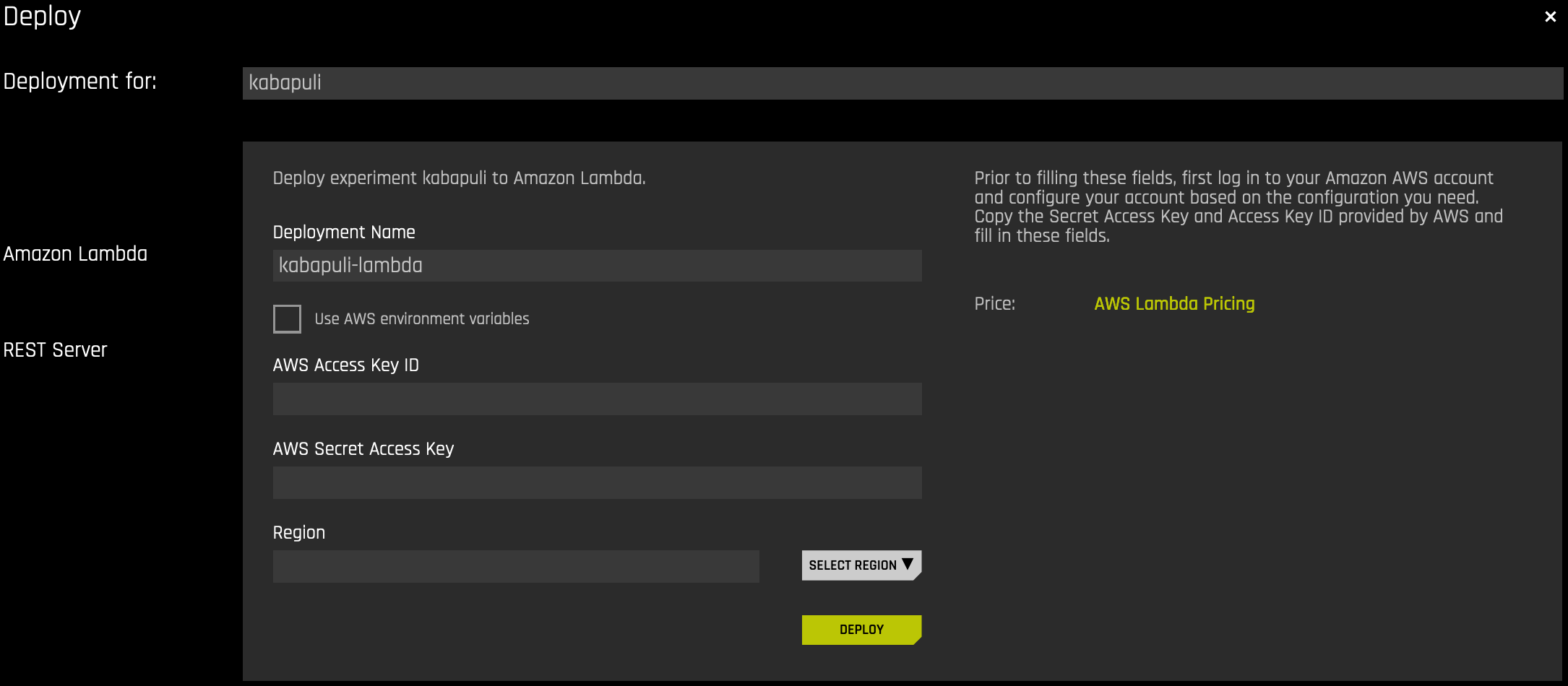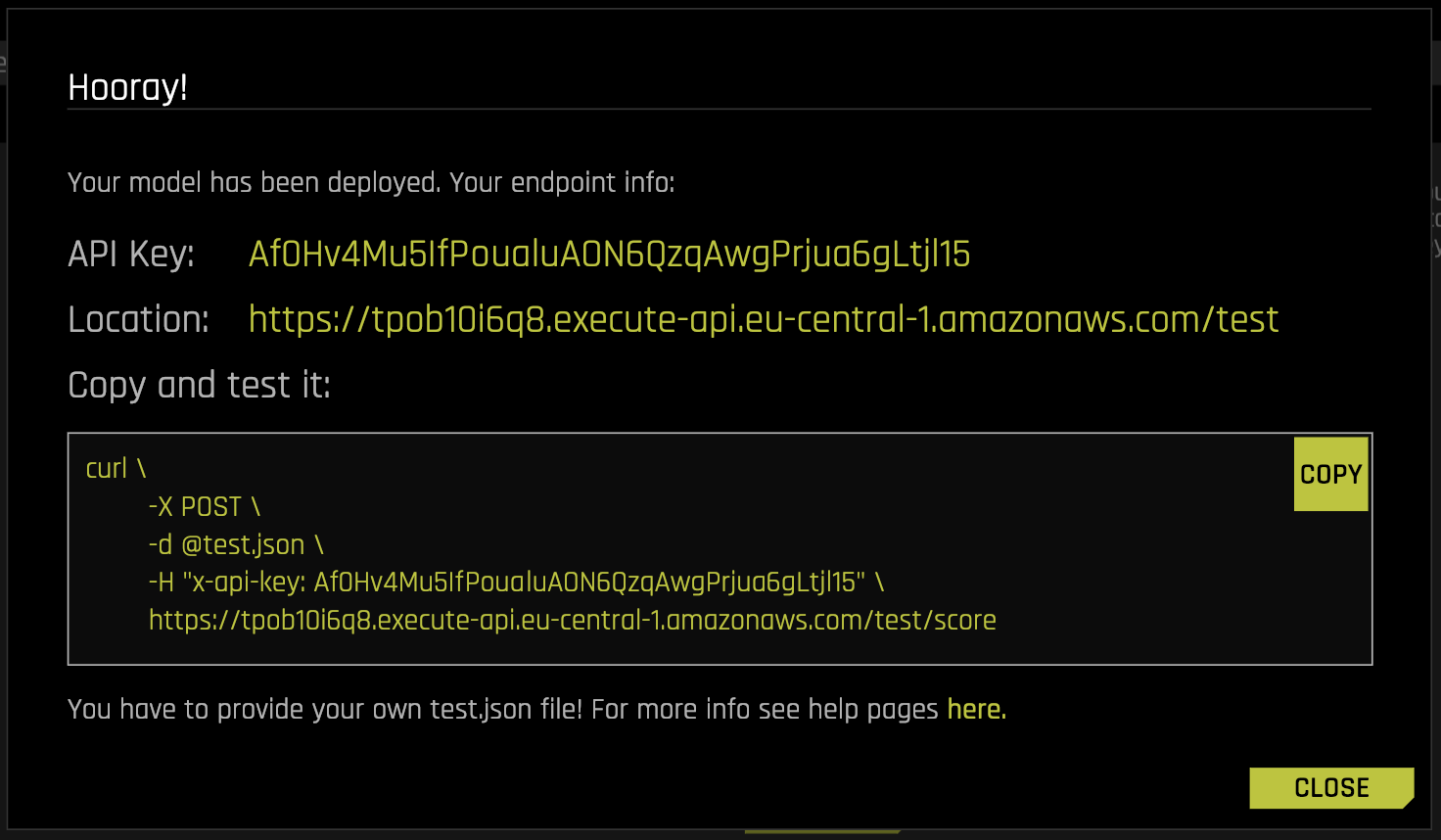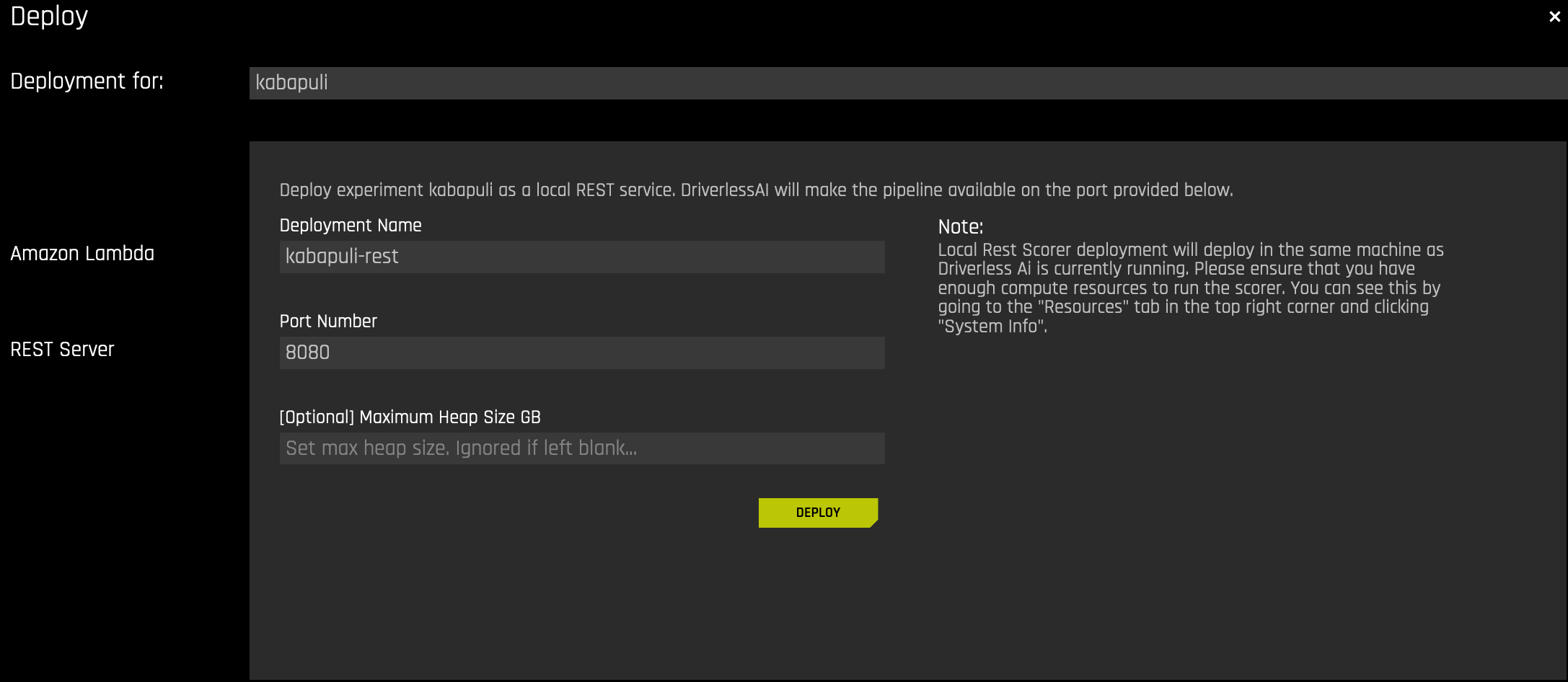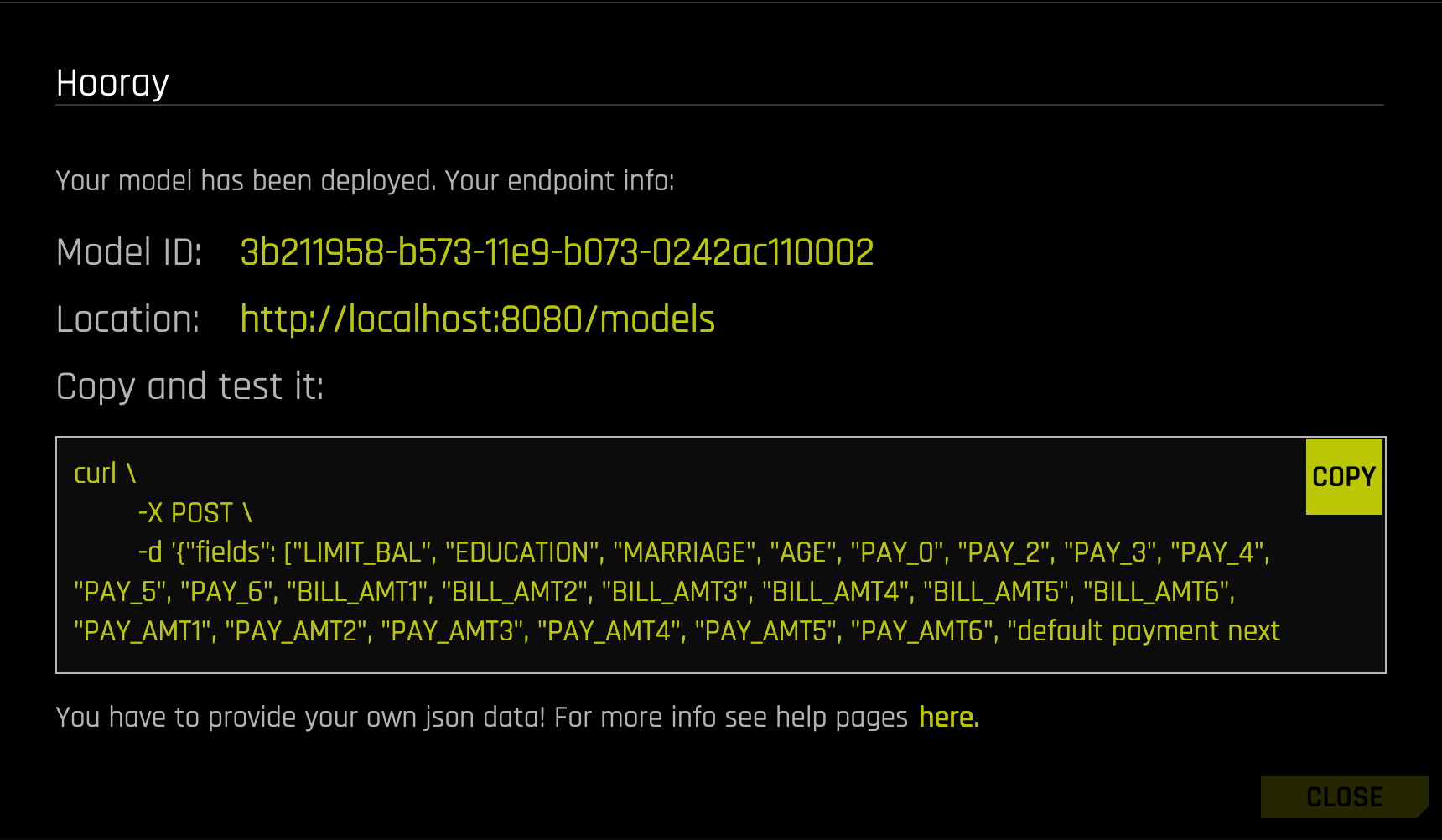Deploying the MOJO Pipeline¶
Driverless AI can deploy the MOJO scoring pipeline for you to test and/or to integrate into a final product.
Notes:
Only MOJO Java runtime deployments are supported.
This section describes how to deploy a MOJO scoring pipeline and assumes that a MOJO scoring pipeline exists. Refer to the MOJO Scoring Pipelines section for information on how to build a MOJO scoring pipeline.
This is an early feature that will continue to support additional deployments.
Deployments Overview Page¶
All of the existing MOJO scoring pipeline deployments are available in the Deployments Overview page, which is available from the top menu. This page lists all active deployments and the information needed to access the respective endpoints. In addition, it allows you to stop any deployments that are no longer needed.

Amazon Lambda Deployment¶
Driverless AI can deploy the trained MOJO scoring pipeline as an AWS Lambda Function, i.e., a server-less scorer running in Amazon Cloud and charged by the actual usage.
Additional Resources¶
Refer to the aws-lambda-scorer folder in the dai-deployment-templates repository to see different deployment templates for AWS Lambda scorer.
Driverless AI Prerequisites¶
Driverless AI MOJO Scoring Pipeline: To deploy a MOJO scoring pipeline as an AWS Lambda function, the MOJO pipeline archive has to be created first by choosing the Build MOJO Scoring Pipeline option on the completed experiment page. Refer to the MOJO Scoring Pipelines section for information on how to build a MOJO scoring pipeline.
Current Driverless AI license. The Driverless AI deployment pipeline to AWS Lambdas explicitly sets the license key as an environment variable. You will not be able to use MOJOs if your Driverless AI license is expired. If you have an expired license, you can update this manually for each MOJO in AWS, or you can update all MOJOs for a deployment region using a script. Refer to Updating Driverless AI Licenses on AWS Lambda for more information.
AWS Prerequisites¶
Usage Plans¶
Usage plans must be enabled in the target AWS region in order for API keys to work when accessing the AWS Lambda via its REST API. Refer to https://aws.amazon.com/blogs/aws/new-usage-plans-for-amazon-api-gateway/ for more information.
Access Permissions¶
The following AWS access permissions need to be provided to the role in order for Driverless AI Lambda deployment to succeed.
AWSLambdaFullAccess
IAMFullAccess
AmazonAPIGatewayAdministrator

The policy can be further stripped down to restrict Lambda and S3 rights using the JSON policy definition as follows:
{
"Version": "2012-10-17",
"Statement": [
{
"Sid": "VisualEditor0",
"Effect": "Allow",
"Action": [
"iam:GetPolicyVersion",
"iam:DeletePolicy",
"iam:CreateRole",
"iam:AttachRolePolicy",
"iam:ListInstanceProfilesForRole",
"iam:PassRole",
"iam:DetachRolePolicy",
"iam:ListAttachedRolePolicies",
"iam:GetRole",
"iam:GetPolicy",
"iam:DeleteRole",
"iam:CreatePolicy",
"iam:ListPolicyVersions"
],
"Resource": [
"arn:aws:iam::*:role/h2oai*",
"arn:aws:iam::*:policy/h2oai*"
]
},
{
"Sid": "VisualEditor1",
"Effect": "Allow",
"Action": "apigateway:*",
"Resource": "*"
},
{
"Sid": "VisualEditor2",
"Effect": "Allow",
"Action": [
"lambda:CreateFunction",
"lambda:ListFunctions",
"lambda:InvokeFunction",
"lambda:GetFunction",
"lambda:UpdateFunctionConfiguration",
"lambda:DeleteFunctionConcurrency",
"lambda:RemovePermission",
"lambda:UpdateFunctionCode",
"lambda:AddPermission",
"lambda:ListVersionsByFunction",
"lambda:GetFunctionConfiguration",
"lambda:DeleteFunction",
"lambda:PutFunctionConcurrency",
"lambda:GetPolicy"
],
"Resource": "arn:aws:lambda:*:*:function:h2oai*"
},
{
"Sid": "VisualEditor3",
"Effect": "Allow",
"Action": "s3:*",
"Resource": [
"arn:aws:s3:::h2oai*/*",
"arn:aws:s3:::h2oai*"
]
}
]
}
Deploying on Amazon Lambda¶
Once the MOJO pipeline archive is ready, Driverless AI provides a Deploy (Local & Cloud) option on the completed experiment page.
Notes: This button is only available after the MOJO Scoring Pipeline has been built.
This option opens a new dialog for setting the AWS account credentials (or use those supplied in the Driverless AI configuration file or environment variables), AWS region, and the desired deployment name (which must be unique per Driverless AI user and AWS account used).

Amazon Lambda deployment parameters:
Deployment Name: A unique name of the deployment. By default, Driverless AI offers a name based on the name of the experiment and the deployment type. This has to be unique both for Driverless AI user and the AWS account used.
Region: The AWS region to deploy the MOJO scoring pipeline to. It makes sense to choose a region geographically close to any client code calling the endpoint in order to minimize request latency. (See also AWS Regions and Availability Zones.)
Use AWS environment variables: If enabled, the AWS credentials are taken from the Driverless AI configuration file (see records
deployment_aws_access_key_idanddeployment_aws_secret_access_key) or environment variables (DRIVERLESS_AI_DEPLOYMENT_AWS_ACCESS_KEY_IDandDRIVERLESS_AI_DEPLOYMENT_AWS_SECRET_ACCESS_KEY). This would usually be entered by the Driverless AI installation administrator.AWS Access Key ID and AWS Secret Access Key: Credentials to access the AWS account. This pair of secrets identifies the AWS user and the account and can be obtained from the AWS account console.
Testing the Lambda Deployment¶
On a successful deployment, all the information needed to access the new endpoint (URL and an API Key) is printed, and the same information is available in the Deployments Overview Page after clicking on the deployment row.

Note that the actual scoring endpoint is located at the path /score. In addition, to prevent DDoS and other malicious activities, the resulting AWS lambda is protected by an API Key, i.e., a secret that has to be passed in as a part of the request using the x-api-key HTTP header.
The request is a JSON object containing attributes:
fields: A list of input column names that should correspond to the training data columns.
rows: A list of rows that are in turn lists of cell values to predict the target values for.
optional includeFieldsInOutput: A list of input columns that should be included in the output.
An example request providing 2 columns on the input and asking to get one column copied to the output looks as follows:
{
"fields": [
"age", "salary"
],
"includeFieldsInOutput": [
"salary"
],
"rows": [
[
"48.0", "15000.0"
],
[
"35.0", "35000.0"
],
[
"18.0", "22000.0"
]
]
}
Assuming the request is stored locally in a file named test.json, the request to the endpoint can be sent, e.g., using the curl utility, as follows:
URL={place the endpoint URL here}
API_KEY={place the endpoint API key here}
curl \
-d @test.json \
-X POST \
-H "x-api-key: ${API_KEY}" \
${URL}/score
The response is a JSON object with a single attribute score, which contains the list of rows with the optional copied input values and the predictions.
For the example above with a two class target field, the result is likely to look something like the following snippet. The particular values would of course depend on the scoring pipeline:
{
"score": [
[
"48.0",
"0.6240277982943945",
"0.045458571508101536",
],
[
"35.0",
"0.7209441819603676",
"0.06299909138586585",
],
[
"18.0",
"0.7209441819603676",
"0.06299909138586585",
]
]
}
AWS Deployment Issues¶
We create a new S3 bucket per AWS Lambda deployment. The bucket names have to be unique throughout AWS S3, and one user can create a maximum of 100 buckets. Therefore, we recommend setting the bucket name used for deployment with the deployment_aws_bucket_name config option.
REST Server Deployment¶
This section describes how to deploy the trained MOJO scoring pipeline as a local Representational State Transfer (REST) Server.
Additional Resources¶
The REST server deployment supports API endpoints such as model metadata, file/CSV scoring, etc. It uses SpringFox for both programmatic and manual inspection of the API. Refer to the local-rest-scorer folder in the dai-deployment-templates repository to see different deployment templates for Local REST scorers.
Prerequisites¶
Driverless AI MOJO Scoring Pipeline: To deploy a MOJO scoring pipeline as a Local REST Scorer, the MOJO pipeline archive has to be created first by choosing the Build MOJO Scoring Pipeline option on the completed experiment page. Refer to the MOJO Scoring Pipelines section for information on how to build a MOJO scoring pipeline.
When using a firewall or a virtual private cloud (VPC), the ports that are used by the REST server must be exposed.
Ensure that you have enough memory and CPUs to run the REST scorer. Typically, a good estimation for the amount of required memory is 12 times the size of the pipeline.mojo file. For example, a 100MB pipeline.mojo file will require approximately 1200MB of RAM. (Note: To conveniently view in-depth information about your system in Driverless AI, click on Resources at the top of the sceen, then click System Info.)
When running Driverless AI in a Docker container, you must expose ports on Docker for the REST service deployment within the Driverless AI Docker container. For example, the following exposes the Driverless AI Docker container to listen to port 8094 for requests arriving at the host port at 18094.
docker run \ -d \ --pid=host \ --init \ --rm \ --shm-size=256m \ -u `id -u`:`id -g` \ -p 12181:12345 \ -p 18094:8094 \ -v `pwd`/data:/data \ -v `pwd`/log:/log \ -v `pwd`/license:/license \ -v `pwd`/tmp:/tmp \ h2oai/<dai-image-name>:TAG
Deploying on REST Server¶
Once the MOJO pipeline archive is ready, Driverless AI provides a Deploy (Local & Cloud) option on the completed experiment page.
Notes:
This button is only available after the MOJO Scoring Pipeline has been built.
This button is not available on PPC64LE environments.
This option opens a new dialog for setting the REST Server deployment name, port number, and maximum heap size (optional).

Specify a name for the REST scorer in order to help track the deployed REST scorers.
Provide a port number on which the REST scorer will run. For example, if port number 8081 is selected, the scorer will be available at http://my-ip-address:8081/models
Optionally specify the maximum heap size for the Java Virtual Machine (JVM) running the REST scorer. This can help constrain the REST scorer from overconsuming memory of the machine. Because the REST scorer is running on the same machine as Driverless AI, it may be helpful to limit the amount of memory that is allocated to the REST scorer. This option will limit the amount of memory the REST scorer can use, but it will also produce an error if the memory allocated is not enough to run the scorer. (The amount of memory required is mostly dependent on the size of MOJO. See Prerequisites for more information.)
Testing the REST Server Deployment¶
Note that the actual scoring endpoint is located at the path /score.
The request is a JSON object containing attributes:
fields: A list of input column names that should correspond to the training data columns.
rows: A list of rows that are in turn lists of cell values to predict the target values for.
optional includeFieldsInOutput: A list of input columns that should be included in the output.
An example request providing 2 columns on the input and asking to get one column copied to the output looks as follows:
{
"fields": [
"age", "salary"
],
"includeFieldsInOutput": [
"salary"
],
"rows": [
[
"48.0", "15000.0"
],
[
"35.0", "35000.0"
],
[
"18.0", "22000.0"
]
]
}
Assuming the request is stored locally in a file named test.json, the request to the endpoint can be sent, e.g., using the curl utility, as follows:
URL={place the endpoint URL here}
curl \
-X POST \
-d {"fields": ['age', 'salary', 'education'], "rows": [1, 2, 3], "includeFieldsInOutput": ["education"]}\
-H "Content-Type: application/json" \
${URL}/score
The response is a JSON object with a single attribute score, which contains the list of rows with the optional copied input values and the predictions.
For the example above with a two class target field, the result is likely to look something like the following snippet. The particular values would of course depend on the scoring pipeline:
{
"score": [
[
"48.0",
"0.6240277982943945",
"0.045458571508101536",
],
[
"35.0",
"0.7209441819603676",
"0.06299909138586585",
],
[
"18.0",
"0.7209441819603676",
"0.06299909138586585",
]
]
}
REST Server Deployment Issues¶
Local REST server deployments are useful for determining the behavioral characteristics of a MOJO that is intended for deployment. However, we don’t recommend using the REST Server deployment as a production level scoring service. The REST Server deployment runs in the same machine as the core of Driverless AI, and therefore has to share system resources with all other Driverless AI processes. This can lead to unexpected scenarios in which competition for compute resources causes the REST Server to fail.
Additionally, given that the memory and CPU resource requirements for the REST scorer and for scoring the MOJO are typically smaller than the requirements for training, it is typically much more cost effective to deploy the MOJO in a smaller instance/machine. Templates can be easily found/built from the repository: https://github.com/h2oai/dai-deployment-templates.
The REST Server will be shut down if Driverless AI is restarted.

